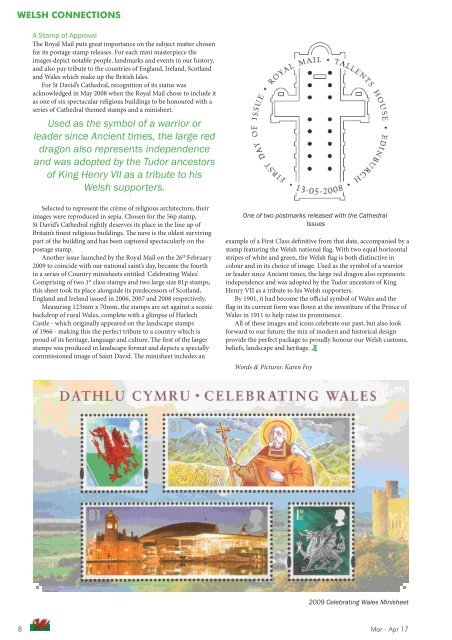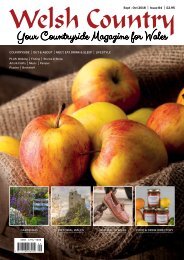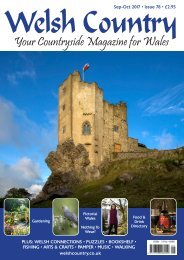Welsh Country March-April 2017
Create successful ePaper yourself
Turn your PDF publications into a flip-book with our unique Google optimized e-Paper software.
WELSH CONNECTIONS<br />
A Stamp of Approval<br />
The Royal Mail puts great importance on the subject matter chosen<br />
for its postage stamp releases. For each mini masterpiece the<br />
images depict notable people, landmarks and events in our history,<br />
and also pay tribute to the countries of England, Ireland, Scotland<br />
and Wales which make up the British Isles.<br />
For St David’s Cathedral, recognition of its status was<br />
acknowledged in May 2008 when the Royal Mail chose to include it<br />
as one of six spectacular religious buildings to be honoured with a<br />
series of Cathedral themed stamps and a minisheet.<br />
Used as the symbol of a warrior or<br />
leader since Ancient times, the large red<br />
dragon also represents independence<br />
and was adopted by the Tudor ancestors<br />
of King Henry VII as a tribute to his<br />
<strong>Welsh</strong> supporters.<br />
Selected to represent the crème of religious architecture, their<br />
images were reproduced in sepia. Chosen for the 56p stamp,<br />
St David’s Cathedral rightly deserves its place in the line up of<br />
Britain’s finest religious buildings. The nave is the oldest surviving<br />
part of the building and has been captured spectacularly on the<br />
postage stamp.<br />
Another issue launched by the Royal Mail on the 26 th February<br />
2009 to coincide with our national saint’s day, became the fourth<br />
in a series of <strong>Country</strong> minisheets entitled ‘Celebrating Wales’.<br />
Comprising of two 1 st class stamps and two large size 81p stamps,<br />
this sheet took its place alongside its predecessors of Scotland,<br />
England and Ireland issued in 2006, 2007 and 2008 respectively.<br />
Measuring 123mm x 70mm, the stamps are set against a scenic<br />
backdrop of rural Wales, complete with a glimpse of Harlech<br />
Castle - which originally appeared on the landscape stamps<br />
of 1966 - making this the perfect tribute to a country which is<br />
proud of its heritage, language and culture. The first of the larger<br />
stamps was produced in landscape format and depicts a specially<br />
commissioned image of Saint David. The minisheet includes an<br />
One of two postmarks released with the Cathedral<br />
Issues<br />
example of a First Class definitive from that date, accompanied by a<br />
stamp featuring the <strong>Welsh</strong> national flag. With two equal horizontal<br />
stripes of white and green, the <strong>Welsh</strong> flag is both distinctive in<br />
colour and in its choice of image. Used as the symbol of a warrior<br />
or leader since Ancient times, the large red dragon also represents<br />
independence and was adopted by the Tudor ancestors of King<br />
Henry VII as a tribute to his <strong>Welsh</strong> supporters.<br />
By 1901, it had become the official symbol of Wales and the<br />
flag in its current form was flown at the investiture of the Prince of<br />
Wales in 1911 to help raise its prominence.<br />
All of these images and icons celebrate our past, but also look<br />
forward to our future; the mix of modern and historical design<br />
provide the perfect package to proudly honour our <strong>Welsh</strong> customs,<br />
beliefs, landscape and heritage. U<br />
Words & Pictures: Karen Foy<br />
2009 Celebrating Wales Minisheet<br />
8 Mar - Apr 17




